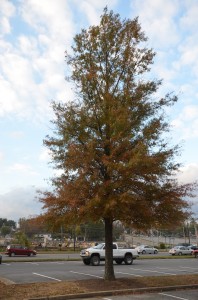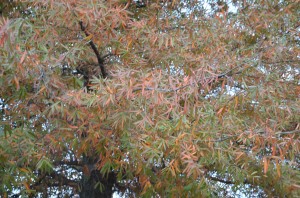Willow oak (Quercus phellos) is medium to large, deciduous tree, part of the red oak group. It is noted for willow-like oak foliage and growth rate after a 2 year establishment period is moderate (USDA hardiness zones 5-9).
Willow oak grows 50-75 feet tall and 30-35 feet wide with a rounded top or canopy. Young trees tend to be pyramidal in form. Individual specimens may reach 90 or more feet under ideal site conditions. Its small ¼ – ½ inch nearly round acorns form almost every year, are not a major maintenance headache, and serve as an important food resource for wildlife.
Long stringy yellow-green long catkin flowers appear in April, a few days before leaves emerge. The unlobed 5-inch long leaves mimic those of willow trees (Salix spp.); leaves are tipped with a single 1-inch wide bristle. Green summer leaf color turns an undistinguished yellow-brown or dull gold very late in autumn. A young tree has a smooth grayish bark which darkens and becomes furrowed with age. From the latin word “phellos”, the species name means cork — because bark on older trees tends to be hard and corky.
Native to the Southeastern United States, willow oak prefers a moist bottomland, organically-rich, and well-drained soil. It tolerates light shade, but performs best in full sun. Willow oak can handle a wide range of soils including clay. Once established, it copes with summer drought well. Foliage is tolerant of urban air pollution.
Willow oak demonstrates good disease and pest resistance and is a long-lived and low-maintenance tree. In a landscape willow oak fits into large sites, such as in public parks or along wide roadways and avenues with good soil mass for adequate moisture. The narrow leathery leaves abscise very late in the fall and make a great loose mulch scattered under other landscape plants.



 Posted in
Posted in 
